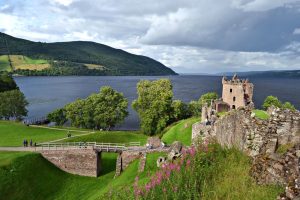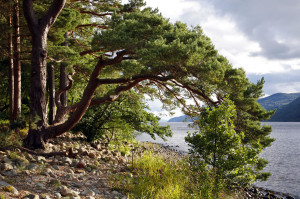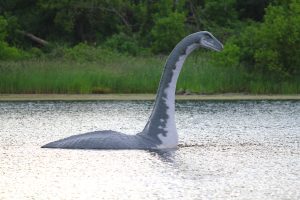
The Loch Ness monster (also known as “Nessie”) is one of the most famous cryptids of all time! A cryptid being an animal whose existence has not been completely verified. Over the decades, many people have seen Nessie and taken photos of her. Shaped like a dinosaur, she has scared the pants off of some visitors to the lake, suddenly popping her head up to look at the scenery. Some people have claimed she makes a loud roar when startled by people, but no audio recordings of Nessie have been found.
Accounts of the Loch Ness Monster go back almost 1,500 years with a great deal of folklore mentioning Nessie throughout the years. The first visual recording of Nessie was an illustration carved into stones around 500AD. Carved by local Picts, the image features a strange aquatic creature in the middle of Loch Ness.

In the 7th-Century an Irish missionary recorded the first written account of the Loch Ness Monster. In the account, Saint Columba claims he saw a monster at the shores of the loch, attacking a man. He invoked the name of god and the beast retreated into the water, never to harm another person!
Modern sightings date back to 1933 when a local couple claimed to have seen “an enormous animal rolling and plunging on the surface”. The number of sightings grew around this time because a new road was built close to the loch. Visitors to the area can drive around Loch Ness searching for Nessie or take a boat trip to see if she pops her head up!
What Could Nessie Be?

There have been many theories about the kind of animal Nessie might be. Some experts suggest that she could be an entirely new species while others think she is a part of a lost dinosaur family, living in the lake for many thousands of years. Nessie might be descended from the Plesiosaur, a long-necked aquatic reptile that supposedly became extinct millions of years ago.
Another possibility is that Nessie is an Archeocyte, a primitive whale with a long serpentine neck. That one has also been extinct for a few million years!
Why did Nessie stay at Loch Ness?
Locals believe Nessie survived at the Loch because it is such a unique and beautiful place. Some amazing facts about Loch Ness:

- It is truly massive! The loch is 56 square km (21.8 square miles) with a maximum depth of 226.96 meters (744.6 feet).
- There is only ONE habitable Castle on Loch Ness.
- It is big enough to hold many Plesiosaur or Archeocyte sized-creatures!
- It is easily the largest lake in Great Britain
- There is more water in Loch Ness than every lake in Wales, Scotland and England combined
- Loch Ness is constantly fed by 7 large rivers and only has one outlet
- The loch never freezes, which also makes it an ideal hideaway for the descendants of dinosaurs!
Combine all of those features and you have the perfect home for Nessie.
Search for the Loch Ness Monster
There have been dozens of searches for Nessie since 1933, including:

- Sir Edward Mountain Expedition (1934) featuring twenty men with binoculars and cameras.
- Loch Ness Phenomena Investigation Bureau (1962–1972) which were devoted to studying Loch Ness.
- LNPIB sonar study (1967–1968) featuring sonar experts from the University of Birmingham, England.
The most recent large-scale search was in 2003 and organised by the BBC. Despite using 600 separate sonar beams and satellite tracking they were unable to find the elusive Nessie!
To this day, thousands of visitors come to Loch Ness to look for Nessie. Even if you don’t get a chance to see the Loch Ness Monster, the area is one of the most pristine natural reserves in the world with dozens of activities to enjoy. Loch Ness is the perfect location for your next holiday!



